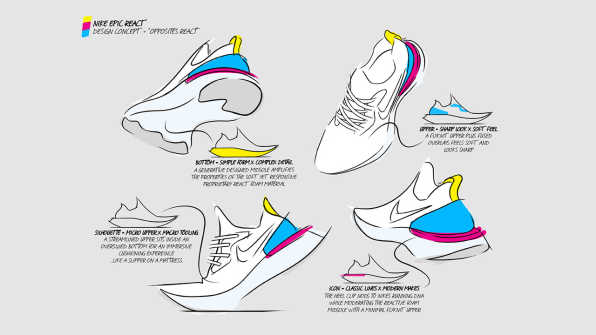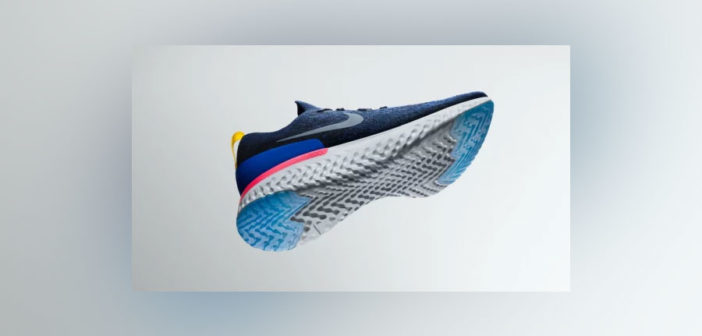John Hoke, head designer at Nike, gives a candid interview about where footwear is going next.
Nike is the largest athletic footwear and apparel manufacturer in the world, at a time when there is little distinction between low fashion and high fashion, or streets and runways. Vice president of design John Hoke, a judge for the 2018 Innovation by Design Awards, is responsible for steering the $34 billion company to the right technologies and the right trends at the right time.

For sneakerheads, the last few years of athletic wear have been fascinating to watch, as Under Armour came out of nowhere to climb up the sales charts, and Adidas teamed up with some of culture’s biggest influencers to become a formidable competitor to Nike.So what’s next for Nike? Just off releasing Flyprint, Nike’s ambitious plan to weave textiles with 3D printers, I chatted with Hoke in a candid interview about the nature of shoe design, how to keep ahead of trends, and where technology will take Nike next. Nike is bullish on pushing the limits of technology, so much so that one day, Hoke hopes your shoes will become symbiotic to your own body, always reacting to your state, and making sure you take every stride with strength.

Fast Company: Something I’ve heard a few times as a design journalist is that designing a shoe is a lot like designing a car. Is that true? Where do you think that philosophy comes from?John Hoke: It’s funny you say that! Over the course of my 25-year history, I’ve spent time with and had deep, engaging conversations with lots of vehicle designers. I think there’s something about the sheer sculptural form of footwear and cars that, if you’re a sneakerhead or you’re a car geek, you’re really obsessed with this idea of a sculpture. Oftentimes, they’ll say you need to sell the car going fast when going still. It has a form factor, body language, a stance that indicates a certain emotion of point of view. Without a doubt, sneakers are the same, because you’re trying to attract consumers on a wall with a quick glance, and a quick interaction, and I think that’s what makes it similar but different. When you sit in a car you’re in a closed environment. When you put the shoe on the foot, we want to enhance that sculptural quality with a surprise and delight of comfort.
FC: You oversee so many different departments at Nike–how do you even come up with a meaningful goal when you come into work in the morning?
JH: It’s a question I try to address every single day. I view the role that I have at the company now as a bit of a standard bearer and a torch bearer. I think both of those activities anchor strongly on our approach to design innovation, which is first and foremost about understanding the complex problems that athletes face, and trying to push ourselves in this relentless pursuit of solving those problems in ever deeper and newer ways, so athletes get to flirt with the impossible, and show us as a human species what we’re capable of doing.
FC: I’ve heard this from Nike, and Adidas, a lot–that it’s all about performance. But you’re selling fashion, too. More people are wearing these shoes on subways than basketball courts. Is it possible that Nike has actually outgrown the performance focus?

JH: I think for us, [performance]has always been our true north. We get to work with the world’s best athletes. Because we sense and understand their ambition, their drive, and their potential, and we think that all of that is transferable to every athlete around the world.
A by-product is your point, products and ideas that become transcendent to cultures and lead, not just in the function side, but the aesthetic and form side. To us, it’s always the marriage of the science with the art, the function with the form, the beauty and the aesthetic with the purpose. It’s hard to pull them apart. When I think about holding a standard for designers, it’s not about how they function, but beautiful function.
FC: So does that mean Nike has made materials and other innovations that work well in terms of performance, but just aren’t pretty enough to be in a shoe?
JH: There are cupboards full of that stuff! Of course! We’re constantly experimenting with materials, and avant-garde thoughts and ideas that, at the end of the day, don’t pass the test of this unique balance of form and function. There are certain things we do at Nike where we’re ahead of the curve, and we’re going to keep this radical expression alive because we think it will create something new.
FC: Your comment on Nike as “radical expression” really makes me think of the minimal shoe trend of the last few years. Bright kicks were in for a long time, and Nike really owns this space with these really optimistic, futuristic hues. Then we saw everyone only wanting to wear something more dystopian–white or black shoes–largely pushed by Adidas. Did minimalism undercut Nike’s own color expressions, and hurt its ability to excite the market with what it does best?
JH: I would say that, I would never pigeonhole Nike into one particular genre. I will say that one thing that deeply resonates with consumers today is the fusion of technology with, I’ll call it craft: a little bit of simplicity with a little bit of a radical approach.
I think my direct answer is, in all fashion cycles, things ebb and flow. I do feel, and do see in the trend work we’re doing, the resurgence of color. It won’t be what it was 3, 5, 10 years ago. I think it will be still based in sport neutrals with some synthetic colors. But I think the assembly of it will be different. The more edited compositions, and radical simplicity, is something I’m trying to advocate at Nike. It’s wearable, understandable; there’s a level of purity and restraint. Simultaneously, we want to say something and project a point of view of confidence in our design.
FC: Sneakerheads and influencers determine so much of the global taste. Is it frustrating, as a designer? How much do you listen to, how much do you tune out?
JH: Let me start by telling you, I have to have a global awareness in my role, in what is emergent and ending, if you will. As part of that, I do spend lots of my time looking at key influencers that I know. Confidants we speak to. And of course the general media, Instagram, and other vehicles showing you where macro trends are accelerating or decelerating.
We live in a time where influence and influencing is its own activity. And I think it has a much deeper impact on the way we self-select things for our bodies, and our fashion, and how we project ourselves. I think it’s a continuous cycle. What I’m excited about is it draws more and more interest into brands like Nike. What is fresh? What is being dropped? What is this larger dialog with this broad public, and my hope is that the broad public design IQ or fashion IQ keeps growing–and because it’s growing it’s seeking more, asking more questions. That makes us have to be stronger, more aware, more on point.

FC: Nike just released Flyprint–not its first, but definitely its largest foray into 3D-printed gear. With a technology like that, are you worried about scalability? And do you think 3D printing will impact the industry at large?
JH: I am a fundamental believer that we in design and creativity are at the dawn of a new age. Literally, I think it’s a massive inflection point in the creative industries to have the power of computational design, craft and calculus together, where generative design meets additive manufacturing. You’re taking the batching process and shrinking it, because, ultimately, there is an eventuality of being able to do 1:1 [one shoe designed for one person]. Flyprint is a giant step forward for us to create product down to the atom, or the nanometer, that’s distinctly for one person.
If you look at the underside of a tongue on a shoe a Nike, it would say “Built to the exact specifications of champion athletes.” Plural. Those standards are aggregated. We’re moving to a point where they will be built to the exact specifications to you, in your sport, when you need it.
FC: Is 1:1 design the ultimate goal?
JH: I don’t think the world is exclusively going to flip into a 1:1 of everything. There will be that wonderful opportunity with a certain clientele, but all those [customized]learnings will be tested to our broad line. And I think that’s going to provide a higher-fidelity craft, more quickly to the marketplace.
FC: For a long time, the future of shoes looked electronic and mechanical. Everyone remembers Tinker Hatfield’s Back to the Future 2design that tied itself. And of course, Nike has dabbled in thatcommercially, but it seems more like you’re looking for innovation in materials, methods of manufacture, and customization, rather than this gadgety approach.
JH: You know, with some of the work you’ve seen the company do in the last couple of years, there is absolutely an arm of Nike, and a deep amount of research and work that is continuing to explore products that use electronics, and use smart materiality to create a more sympathetic, I’ll call it, digitally enhanced footwear experience. My true answer to the question is, we’re on the forefront of that. What we’re doing today is creating quite a stir, not just to the public, but inside our company. There’s this belief that the products we’ve made that are inert are eventually going to become more alive, and because they become more alive, they’ll be more sympathetic, empathetic, and, perhaps, predictive.
It’s the chance for it to be more of you, and more about your movement. And it’s both a collection strategy, and a responsive strategy of product design. And that will take us to a whole other era, where products become services, and static products become dynamic. And I think that could be quite an interesting leapfrogging event in the world of athletics, because it begins to truly be symbiotic with your dynamic body.
FC: I mean that sounds great to me–though I’d say, I’m 35. I don’t need a shoe to dunk anymore. I just want a shoe that can fix lower back pain if it flares up.
JH: I think there are great by-products of things like that, when you have a super technology that’s adjusting, becoming more sympathetic. The eventuality, and now I’m just dreaming, is you are being far more predictive and sympathetic of what the conditions that athletes and consumers are going to run through. A hyper-intelligent athlete is already here. And that hyper intelligence will be a further advantage for athletes and consumers going forward. It’s just a matter of time in how it impacts consumers in completely new ways.
–
This article first appeared in www.fastcodesign.com
Seeking to build and grow your brand using the force of consumer insight, strategic foresight, creative disruption and technology prowess? Talk to us at +9714 3867728 or mail: info@groupisd.com or visit www.groupisd.com


![[Photo: Nike]](https://images.fastcompany.net/image/upload/w_562)